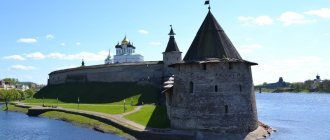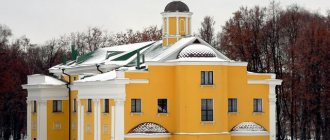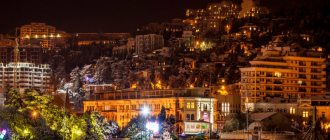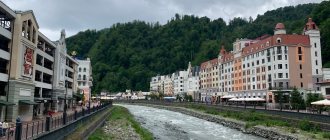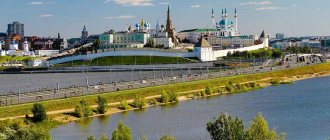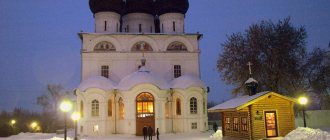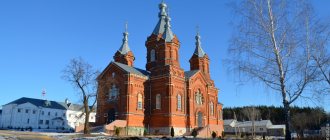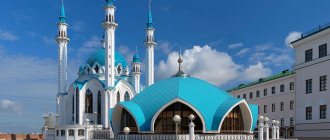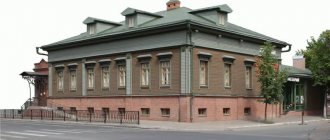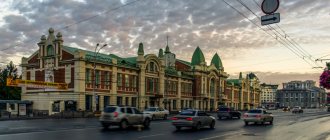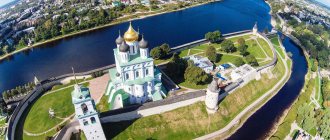> Countries Russia
Pskov is one of the oldest cities in Russia, where unique buildings have been preserved, giving an idea of what medieval Rus' looked like. The rich history has left many architectural and cultural attractions both in the center and in the surrounding area, and many museums. At the same time, the city is actively developing, and new interesting places are appearing. You can expand your trip by visiting ancient monasteries and medieval fortresses in the region or relaxing on the shores of Lake Peipsi. A list of the main points in the center that are easy to get around on foot, as well as travel options nearby, is in this post.
- Sights of Pskov
- Unusual points
- Excursions
- In area
- Museums
- How to get there
- Where to stay
- On the map
In the center
Pskovsky Krom
The Pskov Kremlin (Krom) is the place where Pskov was born in the 10th-11th centuries. At that time, the territory of the Kremlin was relatively small, but gradually new defensive walls appeared around it, and its area increased, dividing the city into Zastenye (behind the first stone walls) and Zapskovye (behind later walls). Impressive fortifications reflected a real need - being located in the very west, on the border with other states, they were constantly under threat of attack and successfully repelled attacks from the Golden Horde, the Livonian Order, Sweden and the State of Lithuania.
Nowadays, inside Krom, the Trinity Cathedral, Dovmontov Castle, the Prikaznye Chambers, as well as defensive walls and towers of the 14th-17th centuries have been preserved. Even today, one is struck by the inaccessibility of the walls, together with the general harmony of the architectural ensemble, rising above the confluence of the Velikaya and Pskova rivers.
st. Kremlin, 2
Opening hours: 06:00 – 22:00
Free admission.
Dovmontov Grad
It’s hard to imagine, but the surviving foundations of 13th-century structures near the Kremlin were discovered only in the 1950s. They allowed us to better understand what architecture was like at that time. It is clearly noticeable that all the buildings stood almost close to each other - as many as ten temples fit into this territory. Next to the foundations is an information board with a picture and description of what they most likely looked like.
Trinity Cathedral
The current 17th-century cathedral is the fourth building on the site of previously burned cathedrals, the first of which was erected by order of Princess Olga. The cathedral, unusually tall for Russian churches, consists of seven tiers, thanks to which it can be seen from different parts of the city. The architecture combines typical Pskov features and features of the Moscow style. Trinity Cathedral is one of the main shrines of the region, where important icons and historical chronicles are kept.
During the time of the Principality of Pskov, a meeting gathered on the square in front of the cathedral, where all important political and social decisions were made. The temple was active until the advent of Soviet power. For some time, an anti-religious museum operated here. Now it belongs to the church again.
Order chambers
The chambers performed an administrative function. Now there is a local history museum. The hipped roof has not been preserved, but a model of the original appearance of the building is inside the museum.
Walls of the Okolny town
The expansion of the Kremlin and fortifications continued due to the walls built in the 16th century around a fairly large area of the current historical center. Surprisingly, most of the walls, three kilometers long, have been preserved and run along modern streets: Kalinin, Sovetskaya and Karl Marx. The complex was also complemented by 50-meter towers, of which only three have survived: Pokrovskaya, Petrovskaya and Mikhailovskaya.
Mirozhsky Monastery
A 12th-century monastery with the only pre-Mongol frescoes preserved in Russia. Soon after its creation, the monastery turned into the cultural center of the city, occupying an increasingly larger area, including the river bank. After the secularization of the lands and the further seizure of the Livonian Order, the territory of the monastery was significantly reduced - approximately to its current size. The oldest and only building that has survived from the founding of the monastery is the Cathedral of the Transfiguration. The remaining buildings date back to the 16th-19th centuries.
Mirozhskaya embankment, 2
Opening hours: Tue-Sun 11:00 – 18:00
Entrance to the monastery territory is free; to church: 200-350 R
Pogankin chambers
One of the oldest residential buildings of the 17th century, which has survived to this day, gives an idea of what the residential buildings of those times looked like. Three multi-storey buildings are built of limestone and whitewashed. There is a legend that the merchant Pogankin, who owned the chambers, walled up his wife in one of the walls. Now the chambers are occupied by the Art Museum-Reserve with an exhibition of paintings.
st. Nekrasova, 7
Opening hours: Tue-Sun 11:00 – 18:00
Entrance: 250 RUR, there are benefits
Cathedral of John the Baptist
One of the oldest Pskov cathedrals is located in the Zavelichye district. The unusual name of the area is due to the fact that it is located on the opposite bank of the Velikaya River from the center. Due to the cultural layer, which has risen by more than a meter, it seems that the temple is gradually going underground. Its architecture displays the features of the Pskov style: simplicity, lack of decoration on the facade and elegance of lines with complete harmony of architectural forms. During Soviet times, the church cemetery was destroyed and the bells were melted down. After a long period of use of the building as a warehouse, a large-scale reconstruction was carried out. Now the appearance of the cathedral is close to the original.
st. Maxim Gorky, 1
Opening hours: 09:00 – 19:00
Free admission
Golden embankment
Golden Embankment is a newly created pedestrian area opposite the Kremlin. There are houses stylized as 19th-century buildings and cafes, but the best thing here is the view of the architectural ensemble of the Kremlin, rising above the confluence of rivers.
Church of Varlaam Khutynsky on Zvanitsa
Like the temple of the same name in Vologda, it received its name in honor of Varlaam Khutynsky, who founded the Spaso-Preobrazhensky Monastery of Novgorod. It was opened in the 15th century to get rid of the plague. The architecture has changed significantly over time, chapels have been added and the roof has been rebuilt.
st. Leona Pozemsky, 53
Free admission.
Embankment of the Velikaya River
Another excellent walking area, completely reconstructed a few years ago. From here you can see the Mirozhsky Monastery and the Zavelichye area.
Church of St. Basil the Great on Gorka
An amazingly beautiful and harmonious temple, rising above a once marshy area. It reflects all the main styles of Pskov architecture of the 15th century: geometric friezes, modest decoration, three-apse structure, whitewashed limestone facade. Unfortunately, the church was heavily rebuilt and the interior was lost, but thanks to its unique architecture, it was included in the UNESCO World Heritage List.
Oktyabrsky p., 5
Free admission
Snetogorsk Monastery
Not far from the center there is a 13th-century monastery - one of the most important shrines in the region. It was here that the princes were tonsured, and unique frescoes were preserved inside, which were whitewashed for a long time and discovered only at the beginning of the 20th century. Surprisingly, the architecture of the cathedral was copied from the main cathedral of the Mirozhsky Monastery, which was a common practice at that time.
Wiki/Commons
st. Snyatnaya Gora, 1
Opening hours: 09:00 – 21:00
Free admission
Where to go in the evening
As you know, in winter the days are shorter and the evenings are longer, so you also want to spend them no less exciting. In the evening in Pskov you can go for a walk or, after looking at the poster, choose spectacular events for yourself.
An evening walk can be much brighter and more attractive if the day was cloudy and monotonous. Take a walk along the embankments of the Velikaya or Pskova , walk along the central streets and near the Kremlin. The silhouettes of Pskov Krom in the light of lanterns and in the soft glow of the snow are mysterious, halftones and shadows in the landscape create the feeling of a fairy-tale setting.
Photo: © Andrey Panin
If desired, the evening program will be supplemented by performances or concerts from cultural institutions of Pskov. The Drama Theater named after A. S. Pushkin is located in a beautiful building from the beginning of the 20th century. It is a branch of the Alexandrinsky Theater in St. Petersburg, holds theater festivals, often becomes a nominee for the Golden Mask Award and actively tours. The drama theater's repertoire includes works from classics to avant-garde - for every taste.
The Pskov Philharmonic Society occupies the building of the House of Political Education. In the 800-seat hall, world classics and modern compositions are played; listeners are delighted by local musical groups and invited performers, including Russian pop stars.
Pskov Drama Theater Photo: © Andrey Panin
The diversity of the poster of the City Cultural Center on the square. Pobeda, 1 and the House of Officers on the street. Divisional Commander Kirsanova, 5. The stage hosts concerts of vocal and dance ensembles, performances, musicals and festivals. Performances by small groups are also hosted at popular bars in the city.
Interesting places
Observation deck with Olginskaya Chapel
Not only does it offer the best view of the Kremlin and Trinity Cathedral, but this place is also associated with the legend of the founding of Pskov. According to her, it was here that Princess Olga stood when she saw three connecting beams on the opposite bank. She took this as a sign that this was a good place for the future of the city. On the opposite bank there is the famous inscription “Russia begins here” - one of the symbols of the city. It refers both to the ancient history of Pskov and to the fact that it is located in the very west of the country.
Zapskovye
Once upon a time, the Zapskovye region, adjacent to the center, was inhabited by Germans and other foreigners. Unfortunately, not a single building has survived from those times, and all foreigners were resettled with the annexation of Zapskovye to Pskov. This is the most cozy area with an inexplicable old Russian atmosphere. Ancient churches can be found every now and then on the quiet streets, and residential buildings consist mainly of wooden houses and low-rise residential areas.
It is also worth looking at the Meyer Rope Factory (22 Leona Pozemsky St.), a pre-revolutionary enterprise in the Art Nouveau style. You can get to Zapskovye by walking along the Golden Embankment and turning right.
Rattling Tower
A 14th-century tower on Gremyachaya Mountain, rising above the Pskovaya River. The impressive tower in a quiet place in Zapskovye has always been shrouded in many legends. For example, that the enchanted prince’s daughter is still sleeping inside, and can only be awakened by someone who reads the psalms at her sarcophagus. However, according to legend, as soon as the young men begin to read, evil spirits appear and throw them out of the tower.
Rusinov Chambers
Another example of residential stone buildings from the 17th century. The complex of buildings, including residential buildings, utility and storage facilities, belonged to the Rusinov family, one of the richest local families of that time. Once Peter I, who knew his family, even stayed in the chambers here. Unfortunately, this unique civil building had not been used for several decades and was in a dilapidated state. Now the building is in great ruins, but complete restoration is planned in the coming years.
The Rusinov courtyard is located on one of the busiest streets - Karl Marx Street. A large number of cafes and restaurants are concentrated on it; the city market is located near the embankment, as well as the pedestrian Pushkin Street.
How to get there
You can get to Pskov by any means of transport, except water:
- Airplane. Pskov airport is called “Crosses” and is located 5 km from the city. You can fly here only from Moscow and St. Petersburg: in the capital, flights are operated by Domodedovo Airport, the journey takes two hours; in St. Petersburg, the flight takes place from Pulkovo Airport, and the travel time is one hour. To get from Kresty airport to Pskov you need to take bus No. 4 or 4A.
- Train. There are four flights daily from Moscow to Pskov. The ticket price starts from 1000 rubles, the journey will take from 12 to 16 hours. Trains depart from Rizhsky, Kursky and Leningradsky stations. The high-speed train “Lastochka” departs from the Northern capital to Pskov daily from the Baltic station. Ticket price: from 650 rubles. Travel time: only 3.5 hours.
- Bus. There are six bus trips from Moscow to Pskov every day. Travel time ranges from 10 to 13 hours, ticket prices start from 1,200 rubles. More than twenty flights depart from St. Petersburg to Pskov every day. The entire journey takes about 4–5 hours, ticket price: from 523 rubles. Buses also go to Pskov from Tallinn, Simferopol, Veliky Novgorod, Smolensk, Riga, etc.
- Automobile. The distance from Moscow to Pskov is 733 kilometers. They can be covered in about 9–10 hours. You should start driving from the capital along the M9 highway, and after the town of Pustoshki turn onto the M20 highway (P23). The road from St. Petersburg goes only along the M20 (P23) highway. The distance between the cities is small - just under 300 kilometers, which can be covered in 2.5–3 hours.
Neighborhood
Pechory
Pechory is a city 50 kilometers from Pskov, where people come primarily for the Pskov-Pechora Monastery. This is one of the oldest monasteries in Russia, founded in the 15th century and since then has never interrupted its work. Since the history of the monastery is extremely rich, it is better to go here on a tour with professional guides. Tours often cover both Pechory and Izborsk - it’s convenient to see both of these places in 1 day.
Izborsk
Izborsk is a small town 30 kilometers in the direction of Pechory. It is considered one of the most ancient cities in Russia, although now it has the status of a village. The main reason to come here is the Izborsk fortress of the 14th century, preserved in very good condition for its advanced age. It’s convenient to get here by bus, car, or with a tour:
Pushkin Mountains
A little further there is a famous and beautiful place - the Pushkin Mountains, located 120 kilometers away. It’s worth devoting at least a whole day to a trip to Pushkin’s places, as they are full of historical sights, and you can learn everything about these places on an individual excursion:
Lake Peipsi
The main lake of the Pskov region, which it shares with Estonia, where it is called Peipsi. It was here that the Battle on the Ice of Alexander Nevsky and the Livonian Order once took place. Now it is a very quiet and peaceful place, and the shore of the lake resembles the shore of the Baltic Sea: sandy beaches surrounded by dense forests. It’s worth a trip here to relax, admire the beautiful scenery, or stay at one of the many coastal resorts.
Wiki/Commons
Smolinskoe Lake
Another picturesque lake in the Palkinsky district. The name comes from the traditional activity of local residents - collecting resin. During the Great Patriotic War, the Germans set up a concentration camp on its banks, traces of which have not survived. Now this is a good direction to go to relax in nature. Smolinskoe Lake is a favorite place for swans, so they are found here quite often.
Museum-estate N.A. Rimsky-Korsakov in Lyubensk
On the way from St. Petersburg, it is convenient to stop by the Rimsky-Korsakov Museum, located not far from Luga in the Plyussky district in the village of Lyubensk. This is an atmospheric place with a restored manor where the composer lived in the last years of his life. The exhibition will tell about these years through personal belongings, household items and a recreated interior.
Reviews from tourists
For some tourists, Pskov becomes an amazing discovery that was very close. Someone looks into the city along the way, making it part of a larger journey. Winter weather does not become an obstacle for guests to get acquainted.
Website users shared their thoughts about what they saw on the streets of winter Pskov:
- Dmitry in the stories with photos “Pskov Auto Voyage - Day 3: from Pskov to Smolensk” and “Pskov Auto Voyage - Day 2: “Island, Izborsk, Pechory”;
- Sergey Vasilets in the material “Pskov region - an idea for the weekend”;
- Konstantin with comments and many photos in the photo album “Pskov”.
All tourist reviews about Pskov on Tourister. RU
History, city transport, weather and other points necessary for organizing a trip:
- City guide
- What to bring from Pskov
Pskov embankment Photo: © vladkonst
Museums
Pskov Museum-Reserve
The museum-reserve occupies several historical buildings: the Kremlin, the Prikazny and Pogankin chambers and a branch on Nekrasova Street. Each of them is a branch with its own exposition on various topics. Usually one of the branches is located in the Pogankin Chambers, but now it is closed for restoration.
Branch on Nekrasova
The exhibition is dedicated to ancient Russian culture and the history of the Pskov region during the Second World War.
st. Nekrasova, 7
Opening hours: Tue-Sun 11:00 – 18:00
Entrance: 300 rub.
Order chamber
The museum will tell you about the history of the chambers and what administrative function they played in Rus'. Temporary exhibitions also change here regularly.
Kremlin
Opening hours: Tue-Sun 11:00 – 18:00
Entrance: 150 rub.
Mason's House
The museum occupies an Art Nouveau mansion that once belonged to the Scotsman Mason. The unusual surname turned into the well-known word “Mason”, which is where the name of the house came from. After the revolution, the building was occupied by communal apartments for a long time, until it was occupied by a museum-reserve, placing a storage facility here. There are also exhibitions open to visitors dedicated to the life of local residents of the century before last and heraldry.
Komsomolsky lane, 6
Opening hours: Tue-Sun 11:00 – 17:00
Entrance: 150 rub.
Kaverin Museum
The Kaverin Museum “Two Captains” is dedicated to the famous novel, but will also tell about the life of the writer. Most of the exhibition is devoted to the history of the creation of the novel; items from the musical “Nord-Ost” and the first editions of the novel are collected. The other part consists of the writer’s personal belongings, from which you learn more about his biography. The museum is now temporarily closed for restoration.
Profsoyuznaya st., 2
Free admission.
Railway Museum
Free Russian Railways Museum opposite the main station. It will be of interest to fans of railway transport and railways in Russia.
st. Jan Fabricius, 29
Opening hours: Tue-Sat 11:00-17:00
Free admission.
What to see with children
Pskov is not a big city, but nevertheless, you can find entertainment popular among modern children - playrooms with bright toys, trampolines, virtual games clubs. If you really want summer and the opportunity to swim, there is the Aquapolis water park for this. But let us note a more unique leisure activity for families with children who come to winter Pskov.
If you are traveling with a child, you can also start your walk from the Pskov Fortress . Older schoolchildren, who have already mastered the history of Ancient Rus', are more familiar than their parents with all the vicissitudes of the events of past years and have probably heard of Pskov, and Princess Olga, and the Battle of the Ice. A walk under the walls of a real fortress will be a vivid impression and a more attractive activity than reading a textbook.
Within the walls of Pskov Krom Photo: © DK1974
The Pskov Museum-Reserve conducts a large number of interactive educational programs. One of them takes place in the Varlaamov Tower; it will clearly tell you about the history of the fortress and military events.
Most other children's excursions are held in the Postnikov Yard . Young visitors will be told about the customs of tea drinking and main dishes in Rus', the construction and life of villages, stove tiles and linen clothing, trading shops and goods in those ancient times. It is proposed to study the ancient customs through a folk tale.
In addition, a special excursion is organized for ready-made groups in winter, which introduces the history and traditions of celebrating the New Year and the Nativity of Christ, and in February - with the traditional fun of Maslenitsa for the children of Pskov’s past.
Children's program within the walls of the fortress Photo: © Sergey Vasilets
As a cultural program, you can also visit the Pskov Puppet Theater . Young viewers can expect well-known productions such as “The Three Bears” or “The Golden Key”, as well as lesser-known stories that can give new emotions. Closer to the New Year, children are also invited to New Year's performances and musicals at the City Cultural Center and the House of Officers .
Where to stay
Pskov has quite a large selection of housing that will suit any budget. For budget travelers, hostels are a great option for one night. The best hostels: Hostel - Pskov, Happy Slud (I personally stayed there, a good option right next to the station), Petrovsky.
The best value for money is found in apartments and hotels in the center: Apartment on ulitsa Gogolya 7 B, Greenfeel Hotel, On Sovetskaya.
The most convenient way to find the best accommodation options is on Hotellook
Excursions
A guided tour is a good way to organize a trip if you want to spend it intensely or have too little time for it. A local guide knows every corner of his city, he will tell you about the main attractions or show you not popular, but interesting or unusual places.
A standard tour of Pskov certainly includes a tour of the Pskov Fortress , a visit to Krom , towers, and merchant chambers. The churches that are unlikely to go unnoticed are the Trinity Cathedral and the Transfiguration Cathedral of the Mirozh Monastery , which preserves unusually skillful frescoes of the 12th century.
A country excursion to Izborsk and Pechory will be convenient for tourists without a car. In one day you can see the most significant places in the vicinity of Pskov. The small village was previously an important city in Rus'. It began with the Truvorov settlement and continued in the Izborsk fortress , which is where the guest can get acquainted. And people go to Pechory to feel the atmosphere of an incredible shrine - an ancient monastery standing on caves.
All excursions around Pskov on Experts Tourist. RU
"Golden Embankment"
Along the river bank there is a magnificent embankment, immodestly popularly called the Golden. The place attracts the attention of tourists with beautiful hotel complexes built in the architectural style of the 19th century. Colorful facades of buildings with decorative elements give the quarter a noble aristocratic ambiance. On the other bank, opposite the palace ensemble lined up in a row, the majestic buildings of the Pskov Kremlin rise.
The landscaped area of the “golden embankment” makes for an ideal, pleasant walk. On the street, paved with decorative tiles, there are lanterns and comfortable benches, as well as tall broad-leaved trees and flower beds.
Second day
Sights of Pskov in 2 days - these are amazing ancient places associated with historical events and famous personalities. They will tell you the history of not only the city, but also the neighboring regional settlements. Pskov and the surrounding area in 2 days is the best way to spend your time. And if you have some time left after the trip, you can spend it in museums or in the places you liked on the first day. In the warmer months, it's worth going on a river walk to see Crom from the water.
Holy Dormition Pskov-Pechersky Monastery
Pskov - Pechory in 2 days is one of the most popular travel options. You need to drive about 50 km from Pskov to get to the Holy Dormition Pskov-Pechersky Monastery . Its foundation dates back to 1473, when the cave church of the Assumption of the Mother of God . The Intercession Church was built above it in the mid-18th century. Now the monastery ensemble includes several more churches, a belfry, a sacristy, ancient fortress walls and holy springs. Surprisingly, during its centuries-old history the monastery has never been closed.
Visitors strive to get into the “God-created caves” (created by God). The hill where they are located is called the Holy Mountain. The nearby caves can be accessed during the working day; the relics of the saints are kept in them. Pre-registration is required to visit the distant caves. They serve as a cemetery for the monastery and are underground galleries with the Church of the Resurrection of Christ. Lay people are also buried in the caves, among whom are the ancestors of A. Pushkin, M. Mussorgsky, M. Kutuzov and others. Here you can examine ancient tombstones.
Details: Pskov-Pechersky Monastery
Pskov-Pechersky Monastery Photo: © Maksim Starostin
Izborsk
The distance from Pskov to Izborsk is about 30 km. People come here to look at the preserved walls and towers of the Izborsk fortress , built in 1330. The first stone building, the Lukovka Tower, has an observation deck. Near the main entrance to the fortress stands St. Nicholas Cathedral, which is mentioned in the chronicles of the 14th century.
Go to Gorodishchenskoye Lake , above which the Truvorovo settlement . This is an ancient settlement that arose at the turn of the 7th–8th centuries and existed before the appearance of the Izborsk fortress. Truvor is one of 3 brothers called to Rus' in 862. He reigned in Izborsk. At the entrance to the settlement there is a stone Truvorov cross. It is believed that it was installed in the XIV-XV centuries. in memory of the original location of the city. On the territory of the settlement there is the Church of St. Nicholas the Wonderworker , erected in the 17th century. In Izborsk, tourists also travel to the Slovenian Springs , a beautiful natural attraction and iconic Orthodox shrine.
If you wish, you can combine a tour of the Pskov-Pechora Monastery and Izborsk, the distance between them is just over 20 km.
Details: sights of Izborsk
Izborsk Fortress Photo: © Victor Bashkir
Snetogorsk Monastery and monument in memory of the Battle of the Ice
If you want to see the sights of Pskov in 2 days without leaving the city, you can visit other interesting places. For example, the Snetogorsky Convent of the Nativity of the Virgin Mary is 6 km from the city center. This UNESCO site is located on Snyatnaya Gora. The history of its foundation goes back to the 13th century. The Cathedral of the Nativity of the Virgin Mary resembles the Mirozh Cathedral in its appearance. It is believed that it was for the construction of this temple that local limestone slabs were used for the first time in church architecture. The Pskov school of painting also began here, when in 1313 the cathedral was painted by local craftsmen. The cathedral is active, you can freely go and see the frescoes.
2 km from the monastery there is a monument in memory of the Battle of the Ice . It was erected in 1993 in honor of the victory of Alexander Nevsky over the knights of the Livonian Order in 1242 on Lake Peipus. They say that warriors went to battle passing through this place. The monument is located on Mount Sokolikha, which offers panoramic views of the city.
Review materials: Guide to Pskov
Sights of Pskov
Monument in memory of the Battle of the Ice Photo: © kolekaterina
Monument to the 6th company
In the village of Cherekha there is a memorable monument dedicated to the heroically killed soldiers of the sixth parachute company in the second Chechen campaign in 2000. A detachment of Pskov paratroopers took on an unequal battle at an altitude of 776 meters in the Argun Gorge with large enemy forces. The basis of the sculptural monument is a parachute. A metal dome with steel slings is installed on a pedestal designed to look like a mountain peak. In the center there are 84 long candles pointing upward. Their number corresponds to the number of bravely killed soldiers.
At the foot of the monument there are granite slabs on which the names of the paratroopers are engraved. In the inside of the parachute dome you can see copies of the autographs of all the fighters. The building is crowned with the star of the Hero of Russia.
City of Pskov (Russia)
Pskov is one of the oldest cities in Russia and the center of the region of the same name. It was founded at the beginning of the 10th century and is famous for a whole scattering of Russian medieval monuments of history, culture and architecture from the 12th to 17th centuries. Pskov is a city with many magnificent ancient churches and an impressive fortress with mighty walls and towers, in the structure of which its core stands out - Krom or the Kremlin. This is a place with an amazing (for our country) concentration of ancient attractions, which “breathes” tranquility and thousands of years of history.
Geography and climate
Pskov is located in northwestern Russia near the border with Estonia and Latvia. The city lies on the lowland of the same name on the Velikaya River, where the Pskova River flows into it. Pskov Lake is 16 km away.
Pskov has a transitional climate from maritime to temperate continental. Summer here is relatively warm and quite rainy. Winter is cool, with usually persistent light frosts, which can be replaced by thaws.
Ancient Krom - the oldest part of Pskov
Trinity Cathedral
The pearl of the Pskov Kremlin is the Holy Trinity Cathedral. Previously, on the site of the current temple, a wooden church was founded at the behest of Princess Olga in the 10th century. It is noteworthy that by that time Christianity did not yet have the status of an official religion in Rus'. The snow-white modern cathedral, which now delights with its beauty, was built in 1699. The masterpiece of ancient Russian architecture dominates the walls of the fort and is perfectly visible from anywhere in the city. The shrine, quadrangular in plan, rises 78 meters into the air.
The temple is crowned with five domes - the central tent sparkles with gilding, the other four bulbs are painted gray. The facade of the church is decorated with protruding vertical ribs, narrow window openings are decorated with platbands and elements made of relief stucco. The rich interior decoration of the Trinity Cathedral evokes a feeling of awe among parishioners.
The halls are divided among themselves by high square columns. The seven-tiered iconostasis with exquisite wooden openwork ornaments is striking. Its height is 48 meters. The vaults are unusually painted to resemble the starry sky. The temple houses miraculous ancient images and relics of saints.
Order chambers
The only administrative building on the territory of the Kremlin, where the administrative apparatus of the voivodeship met, was called the Order Chambers. The 17th-century building is a two-story white rectangular building made of limestone slabs with thick walls, a hipped roof, a massive stone porch and a high staircase.
The chambers were divided into five departments, each of which performed its own tasks and decided the fate of the Pskov residents. The office desks of the embassy, finance, land, army and court were also located here. The premises have recreated the original working environment of the governor and officials of the Middle Ages.
Church of St. Nicholas of Usokha
In the old days, a dried-up bed of a small stream or a swamp was called a dry riverbed, so this temple was named partly on a geographical basis. The church has been on this site since the 14th century. The current building - square in plan with several chapels, domes, a belfry and an adjacent chapel - was built in the middle of the 16th century.
The church suffered greatly in 1941–1944. Immediately after the war and in the 1960s, two reconstructions took place, and in 2008, services were resumed in the Temple of St. Nicholas of Usokha.
